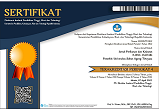Preliminary Study of Caridina kaili Domestication, Endemic Shrimp to Lake Lindu, Central Sulawesi, Indonesia
Abstract
Keywords
Full Text:
PDFReferences
Annawaty, Wowor D. 2015. The atyid shrimps from lake Lindu, Central Sulawesi, Indonesia with description of two new species (Crustacea: Decapoda: Caridea). Zootaxa, 3957(5): 501-519. DOI: 10.11646/zootaxa.3957.5.1.
Annawaty, Wowor D, Fajarallah A, Setiadi D. 2016. Habitat preference and distribution of the freshwater shrimps of the genus Caridina (Crustacea: Decapoda: Atyidae) in lake Lindu, Sulawesi, Indonesia. HAYATI Journal of Biosciences, 23 (2): 45-50. DOI: 10.4308/hjb.23.2.45.
Azis. 2008. Perangsangan molting pascalarva lobster air tawar jenis capit merah (Cherax quadricarinatus, von Martens) dengan perlakuan suhu [Tesis]. Bogor: Sekolah Pascasarjana, Institut Pertanian Bogor. 78 hlm.
Chang ES. 2005. Stressed-out lobsters: crustacean hyperglycemic hormone and stress proteins. Integr. Comp. Biol., 45(1): 43-50. DOI: 10.1093/icb/45.1.43.
Chang ES, Mykles DL. 2011. Regulation of crustacean molting: a review and our perspectives. General and Comparative Endocrinology, 172 (3): 323-330. DOI: 10.1016/j.ygcen.2011.04.003.
Frotedar S, Evans L, Jones B. 2006. Effect of holding duration on the imune system of western rock lobster Panulirus cygnus. Comparative Biochemistry and Physiology Part A, 143 (4): 479-487. DOI: 10.1016/j.cbpa.2006.01.010.
Hadiroseyani Y, Sukenda, Surawidjaja EH, Utomo NBP, Affandi R. 2016. Survival rate of transported ricefield eels Monopterus albus (Synbranchidae), in open and closed system at water salinity level of 0 and 9 g L-1. AACL Bioflux, 9(3): 759-767.
Haryono, Rahardjo, MF, Affandi, R, Mulyadi. 2017. Karakteristik morfologi dan habitat ikan brek (Barbonymus balleroides Val. 1842) di sungai Serayu Jawa Tengah. Jurnal Biologi Indonesia. 13(2): 223-232. DOI: 10.14203/jbi.v13i2.3396.
Herjayanto M, Waris A, Suwarni Y, Halia M, Gani A, Findayani N, Cahyani R. 2018. Studi habitat dan pengangkutan sistem tertutup pada ikan rono Oryzias sarasinorum Popta, 1905 endemik Danau Lindu sebagai dasar untuk domestikasi. Jurnal Akuatika Indonesia, 3(2): 103-109. DOI: 10.24198/jaki.v3i2.23396.
Hosamani N, Reddy SB, Reddy RP. 2017. Crustacean molting: regulation and effects of environmental toxicants. J. Marine Sci. Res. Dev., 7(5): 1-8. DOI:10.4172/2155-9910.1000236.
Humairani, Supriyono E, Nirmala K. 2016. Penambahan zeolit, karbon aktif, minyak cengkeh dan salinitas yang berbeda terhadap respon glukosa, tingkat kerja osmotik dan histologi benih udang galah pada simulasi transportasi tertutup dengan kepadatan tinggi. Jurnal Ilmu dan Teknologi Kelautan Tropis, 8(1): 215-226.
Lukman. 2007. Danau Lindu keteduhan yang merindu. Jakarta: LIPI Press. 68 hlm.
Nirmala K, Hadiroseyani Y and Widiasto RP. 2012. Penambahan garam dalam air media yang berisi zeolit dan arang aktif pada transportasi tertutup benih ikan gurami Ospronemus goramy Lac. Jurnal Akuakultur Indonesia, 11(2): 190-201.
Tjakrawidjaja AH, Subagja J. 2009. Teknik pengangkutan dan pengadaptasian ikan tambra dari habitat alaminya DAS Hulu Barito Kalimantan Tengah. Editor Haryono, Rahardjo MF. Proses domestikasi dan reproduksi ikan tambra yang telah langka menuju budidaya. Jakarta: LIPI Press. 37-49 hlm.
Wittmann AC, Benrabaa SAM, López-Cerón DA, Chang ES, Mykles DL. 2018. Effets of temperature on survival, moulting and expression of neuropeptide and mTOR signaling genes in juvenile dungeness crab (Metacarcinus magister). Journal of Experimental Biology, 221: 1-13. DOI: 10.1242/jeb.187492.
DOI: http://dx.doi.org/10.33512/jpk.v9i2.8629
Refbacks
- There are currently no refbacks.



_-_Copy1.png)